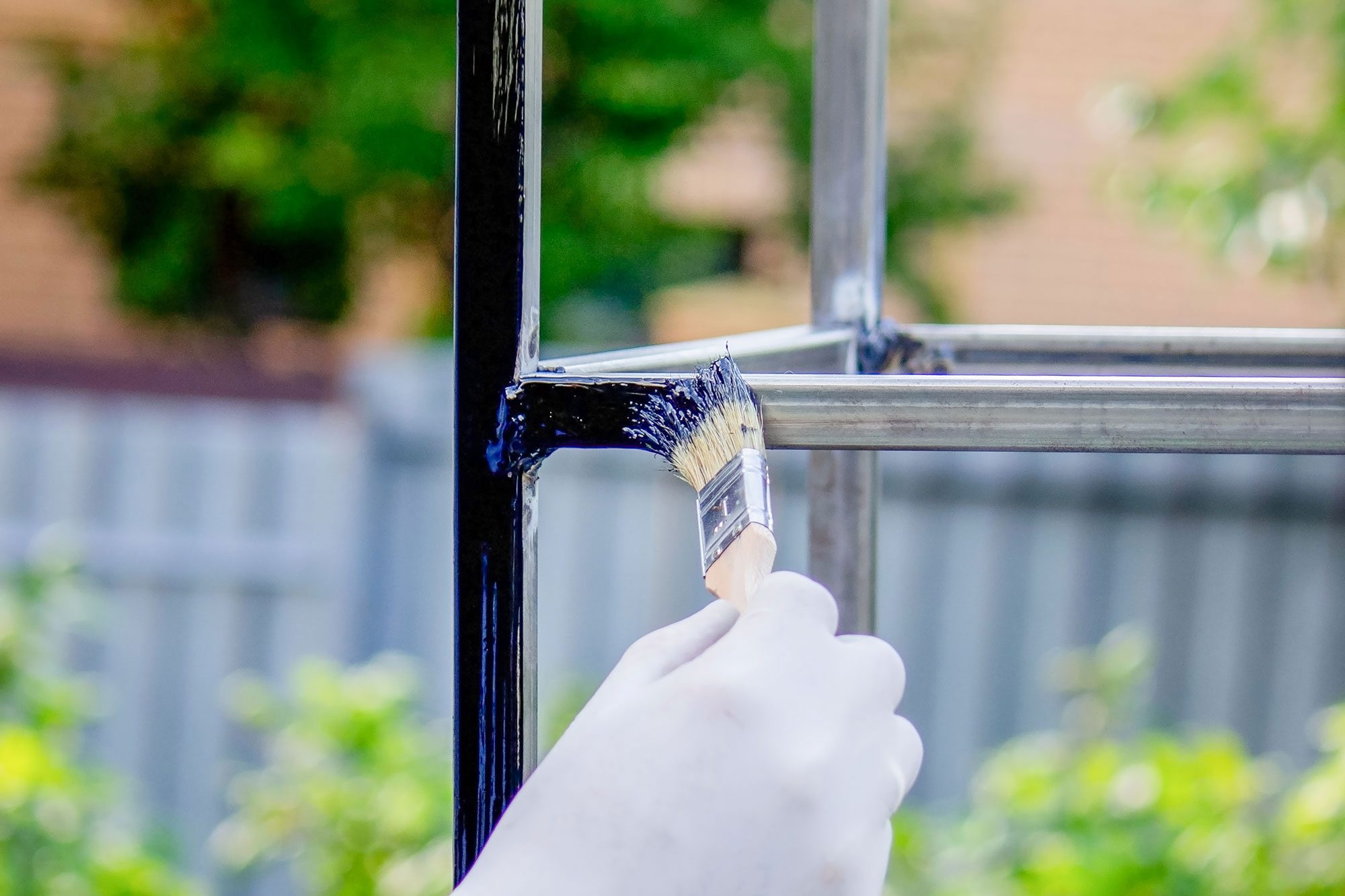Elevate your next home project with acrylic paint on metal. Learn expert tips for durable, long-lasting results.

Can You Paint on Metal with Acrylic?

If you’re planning to paint on metal as part of your next home improvement project, acrylic paint is a great option. Suitable for all metal types including steel, iron, aluminum and galvanized, acrylic paint usually requires a primer and thorough prep.
I’ve used acrylic paint on chain link fences, patio furniture and railings with great results. Rachel Otto, a Benjamin Moore paint specialist at Fleury Lumber in Easthampton, Massachusetts, recommends it as well. “Acrylic paint is very versatile, adheres well to metal and anyone can do it,” she says.
Here, we’ll break down the benefits of using acrylic paint on metal, get expert tips on prep and application methods, and make recommendations for various project types.
On This Page
Benefits of Acrylic Paint on Metal
Acrylic paint offer a lot — quick dry and re-coat times, excellent color retention and easy application. Acrylics also produce less odor during application than oil-based paint.
It also cures to a similar hardness as oil-based paint. Although acrylic takes longer to cure, its finish remains flexible and strong over time.
“Acrylic paints generally allow more expansion and contraction because they always stay somewhat rubbery or flexible,” says Doug Curving, a sales and service representative with Valspar for Sherwin-Williams.
Many manufacturers make acrylic paint. There are lots of options for sheens, color and application types, which can be brushed, rolled or sprayed. Acrylic paint also offers easy cleanup without the use of solvents.
Does Acrylic Paint Wash Off Metal?
No, if properly prepped and applied.
“Like any paint, it will start to run or wash off as it wears out and the protective enamel that forms when it dries starts to break down, but it’s not just going to wash off the surface,” Otto says. “It sticks quite well.” It won’t wash off with soap and water after its cured, either.
How Do You Prepare Metal for Acrylic Paint?
The key to successfully painting metal with acrylic paint starts with thorough prep work. “You want it clean, dry and dull for the best adhesion,” Curving says.
Cleaning can be accomplished with soap and water to remove dirt and dust, or a general purpose cleaner, like Simple Green. Otto recommends trisodium phosphate (TSP) to clean new, bare metal that may have factory glazing or oil from the manufacturing process.
If your metal is rusted or previously painted, use a wire brush, sandpaper or a wire brush drill attachment to remove as much rust and flaking paint as possible. Whether you intend to use a primer or not depends on how much rust needs to be removed.
“If you’re not going to prime it, you’ll need to get all the rust off and get down to clean metal, otherwise that rust will continue to break down, and your paint will flake off,” Otto says. If you are planning to prime, removing rust provides a solid surface for paint.
Galvanized metals should be cleaned with vinegar to break down the zinc coating, then primed and painted. Benjamin Moore’s Ultra Spec HP Acrylic Metal Primer can be used on galvanized as well as rust-free aluminum, steel and iron.
If painting over rusted metal, Otto says, “use a rusted metal primer.” Rust-Oleum’s Stops Rust is an excellent product. Use Rusty Metal Primer on heavily rusted surfaces and Clean Metal Primer for bare metal or lightly rusted surfaces. These primers cannot be used on galvanized metal.
Best Type of Acrylic Paint for Metal
Most acrylic paints meant for home use can be applied to metal surfaces with proper prep and priming.
Benjamin Moore’s Ben, Aura and Regal interior and exterior lines of acrylic paints all work on primed metal surfaces, and are available in various colors and sheens. Sherwin-Williams’ SuperPaint, an acrylic for interior and exterior uses, can also be applied to properly primed metal.
Self-priming direct-to-metal (DTM) products also can be applied directly to rust-free metal surfaces. Benjamin Moore’s UltraSpec comes in low-lustre, gloss and semi-gloss finishes. “It adheres beautifully and has excellent shine,” Otto says.
According to the product’s technical data sheet, these paints can be used on most interior or exterior metal surfaces, including steel, iron and aluminum.
Valspar’s Metal Building Siding and Roof Finish is another great DTM product for exterior applications.
Application Tips
- Be sure to consider the manufacturer’s recommended weather and temperature conditions. “You don’t want the metal to be too hot or too cold,” Curving says. “If it’s too hot, it will dry too fast, and if it’s too cold it won’t adhere well. Watch not just the air ambient temperature, but the surface temperature too.” Humidity levels will also affect drying times, which can impact performance. So can rain soon after application.
- Acrylic paint can be applied with a brush, roller or sprayer. Choose a high-quality nylon/polyester bristle brush. If rolling, use a woven synthetic cover in the nap thickness appropriate for your project. Follow the paint manufacturer’s thinning instructions for sprayers.
- Otto reminds painters to work in a well-ventilated space or outdoors, if possible.
Does Acrylic Paint on Metal Need To Be Sealed?
No. “Just use a good acrylic paint and once it’s fully cured and dry, you’re good to go,” Curving says.




















